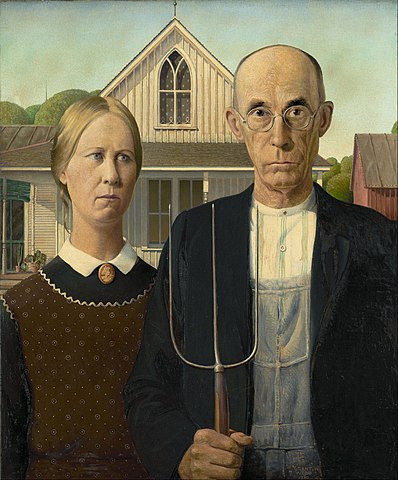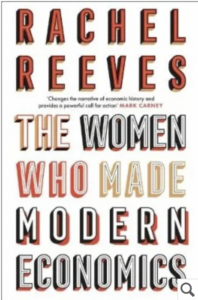Serious shopping

Swiss Cottage, London.
Quote of the Day
“For most of history the challenge of technology lay in creating and unleashing its power. That has now flipped; the challenge of technology today is about containing its unleashed power, ensuring that it continues to serve us and our planet.”
- Mustafa Suleyman
Topical, given that the ‘AI Safety Summit’ opens in Bletchley Park on Wednesday.
Musical alternative to the morning’s radio news
Vaughan Williams | Just as the tide was flowing | arranged by John Rutter | Cambridge Singers
Long Read of the Day
Beyond the Myth of Rural America

Lovely — and thought-provoking — New Yorker essay by Daniel Immerwahr about the way the reality of rural life in the US has been misrepresented and misunderstood by the wider world.
Demanding that your friend pull the car over so you can examine an unusual architectural detail is not, I’m told, endearing. But some of us can’t help ourselves. For the painter Grant Wood, it was an incongruous Gothic window on an otherwise modest frame house in Eldon, Iowa, that required stopping. It looked as if a cottage were impersonating a cathedral. Wood tried to imagine who “would fit into such a home.” He recruited his sister and his dentist as models and costumed them in old-fashioned attire. The result, “American Gothic,” as he titled the painting from 1930, is probably the most famous art work ever produced in the United States.
The painting was also decidedly enigmatic. Was it biting satire? Grim realism? Proud patriotism? In the words of the late Thomas Hoving, a longtime director of the Metropolitan Museum of Art, the image served as a “Rorschach test for the character of the nation.”
For Wood, however, the meaning was clear. Although he faced “a storm of protest from Iowa farm wives”—one threatened to “smash my head,” he recalled—he had painted “American Gothic” with sympathy. Cities dominated culture, he wrote, yet they were “far less typically American” than the rural places “whose power they usurped.” In 1935, Wood, who was born on an Iowa farm forty-four years earlier, published the manifesto “Revolt Against the City.”
I had always taken the picture at its face value. Silly me. And this piece has a nice photograph which includes the two models Wood used for the couple in the picture.
Artists may make AI firms pay a high price for their software’s ‘creativity’
Yesterday’s Observer column:
Let us examine how Midjourney and its peers do their tricks. The secret lies mainly in the fact that they are trained by ingesting the LAION-5B dataset – a collection of links to upwards of 6bn tagged images compiled by scraping the web indiscriminately, and which is thought to include a significant number of pointers to copyrighted artworks. When fed with a text prompt, the AIs then assemble a set of composite images that might resemble what the user asked for. Voilà!
What this implies is that if you are a graphic artist whose work has been published online, there is a good chance that Midjourney and co have those works in its capacious memory somewhere. And no tech company asked you for permission to “scrape” them into the maw of its machine. Nor did it offer to compensate you for so doing. Which means that underpinning the magic that these generative AIs so artfully perform may be intellectual property (IP) theft on a significant scale…
Books, etc.

If the opinion polls are an accurate guide, Britain’s next Chancellor of the Exchequer (aka Finance Minister) will be a double first: the first woman to hold the post, and the first Chancellor who seems interested in the history of economics. Her book came out this week and has attracted attention, mostly from hacks who are looking for clues to what a Starmer government might do, and critics who delightedly discovered that a few passages appear in the book appear to have been copied from unreferenced sources, including Wikipedia — mistakes that both Reeves and her publisher have acknowledged and which apparently will be fixed in a second edition (if there is one).
The review that most intrigued me was in the Financial Times, which concluded thus with a nice piece of ambiguity:
The Women Who Made Modern Economics is an audition piece, clearly intended to demonstrate that Reeves is a serious, thoughtful contender to run Britain’s economy. It also does the valuable job of challenging readers’ preconceptions of what an economist it. But perhaps the most important lesson to come out of it is the importance of giving credit where it is due.
Nice sting in the end, eh? And the author of the piece? Why one Soumaya Keynes, who is an FT economics columnist — and also the great-great-niece of John Maynard Keynes!
My commonplace booklet
A Message from your Batty Old Hungarian Vampire Granny
Or why Margaret Attwood’s Substack blog is a thing of beauty and a joy forever.
This Blog is also available as an email three days a week. If you think that might suit you better, why not [subscribe]? One email on Mondays, Wednesdays and Fridays delivered to your inbox at 6am UK time. It’s free, and you can always unsubscribe if you conclude your inbox is full enough already!
